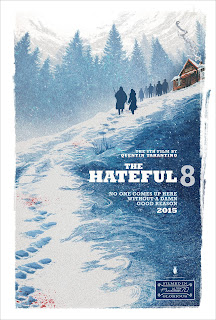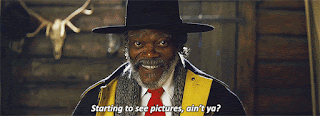Tarantino’s latest movie isn’t on the “epic” scale of
the French and Jews murdering Nazis, nor is it the valiant knight Django saving
Broomhilda from the Dragon in hellfire. No, we’re going back to basics! To the
Reservoir Dogs and Pulp Fiction-era of Tarantino.
The movie begins with wide shots of the snowy
mountains, forests and a wooden carving of crucified Jesus Christ covered in
snow… and then! Ennio Morricone’s composed soundtrack for
the Hateful Eight begins, kicking off the Snow Western in gear.
It’s the post-civil-war America and what happens when
you put 8 strangers: Joh Ruth the Hangman (Played by Kurt Russell), Major
Marquis Warren the Bounty Hunter (played by Samuel L. Jackson), Chris Mannix
the Sheriff (played by Walton Goggins), Daisy Domergue the Prisoner (played by
Jennifer Jason Leigh), a Little British man, a Mexican, the Cow Puncher and a
Confederate General in the same room with guns for a hellish blizzard night?
You’re going to have some dead bodies rolling over!
Samuel L. Jackson steals the whole show alongside
Walton Goggins, they receive the best snippets of dialogue, character exchanges
and the jokes, but holy shit does Jennifer Jason Leigh transform into a monster
through the movie, she is the nastiest vile bitch I’ve seen in a long while
when it comes to horror.
John Ruth is an advocate of civil liberties and
opposes slavery, but has never talked to any African American before meeting
with Marquis; and even still only shows respect to him, because he is pen pals
with Abraham Lincoln.
Whereas the Southern Sheriff Chris Mannix, a once high
ranking member of the Mannix Marauders, who we could identify as sort of
pre-KKK organization. Slaughtered a fair share of African American slaves,
reassures he only fought in the far because the North demanded too much from
their Southern brothers.
Even the Warren himself, brags proudly how he joined
the military just to murder white people, regardless of their faction on the
cause.
Then we have Daisy Domergue, who is race is hating
criminal with no moral compass, but she is the most honest of them all. She isn’t
hiding behind anything political or higher moral, she is just out there for
herself and is willing to kill everyone who steps on her way.
The main gist of the movie, the very core and heart of
the movie is, how we have separated ourselves by race and politics; while we
should strive for the dreams and idealisms we’re constantly yanking all about.
That is why the reveal of the Lincoln letter that
Marquis possesses is so important to the movie, you just want to keep hear
reading it.
I have seen Hateful Eight twice by now and would like
to see it again, because the ideas the movie invokes just engages for
conversation more than those Academy award begging flicks.












